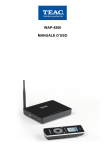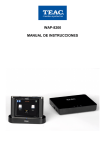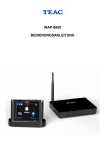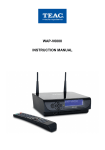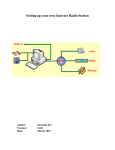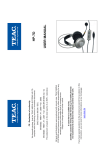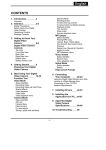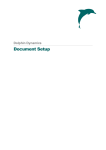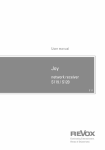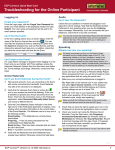Download WAP-4500 instruction manual - Pdfstream.manualsonline.com
Transcript
WAP-4500 INSTRUCTION MANUAL 2 WAP-4500 INSTRUCTION MANUAL Index 1. After unpacking......................................................................................................5 2. Controls and connectors........................................................................................6 3. Assembly ..............................................................................................................7 4. BRC Battery installation.........................................................................................8 5. Pairing the BRC and SMR ....................................................................................9 6. Operation.............................................................................................................10 6.1 Audio Server operation ....................................................................................12 6.2 Internet Radio....................................................................................................13 6.3 USB Audiomanager...........................................................................................15 6.4 PLAYLIST Direkt-/Playlist toggle function .........................................................16 7. Special functions..................................................................................................17 7.1 Multiroom-operation: select the SMR for control................................................17 7.2 Recording of Internet Radio contents.................................................................18 7.3 Import of Internet Stations by USB storage........................................................19 8. Settings................................................................................................................20 8.1 Multiroom: .........................................................................................................20 8.2 Language: .........................................................................................................21 8.3 Screen: ..............................................................................................................21 8.4 Autostart: ...........................................................................................................21 8.5 NTP:...................................................................................................................21 8.6 Date: .................................................................................................................21 8.7 Time: .................................................................................................................21 8.8 Sleep: ................................................................................................................21 8.9 Network: ............................................................................................................22 8.9.1 Network Interface............................................................................................22 8.9.2 Wireless Connection (WLAN).........................................................................22 8.9.3 Wireless Lan Setting Wizard...........................................................................22 8.9.4 IP Settings (IP settings for LAN and WLAN)...................................................23 8.9.5 Advanced WLAN settings...............................................................................23 8.10 UPGRADE: firmware (F/W) upgrade...............................................................24 9. Troubleshooting...................................................................................................25 10. Advice on location, care and safety...................................................................27 11. Specifications:....................................................................................................28 12. CE – Declaration of conformity ....................................................................29 13. Notes on WEEE.................................................................................................29 14. Warranty request card.......................................................................................30 3 4 Dear User, we are pleased that you have chosen a wireless media player from TEAC media systems and congratulate you on this choice. With your TEAC media systems WAP-4500 you have acquired a modern piece of wireless audio technology that is in equal measure attractive and of high quality. We are sure that this product will provide useful service and a lot of fun over the coming years. ... your TEAC media systems team! 1. After unpacking After unpacking you should first check that the contents are complete. In addition to this printed manual there should be: ● The WAP-4500 streaming media receiver (SMR in this manual) ● The WAP-4500 bidirectional remote control (BRC in this manual) ● A power supply for SMR with DC connector. ● One audio connection cable with mini phone plug and RCA plugs ● The installation CD. Beside the Media Server software, you will also find latest firmware, instruction manual in PDF format and a PC background picture to decorate your PC desktop. 5 2. Controls and connectors Bidirectional Remote Control (BRC): Streaming Media Receiver (SMR): 1 = LC-Display 2, 3, 4 = Softkeys 5 = Muting 6 = Standby 7 = OK Play Pause 8 = go Left / Fast Rewind 9 = go Right / Fast Forewind 10 = go Up / Previous item 11 = go Down / Next item 12 = Volume down (-) 13 = Volume up (+) 14 = Battery bay A = DC connector for power supply B = Ethernet cable connector (RJ-45) C = Left channel Line output (RCA) D = Right channel Line output (RCA) E = S/PDIF optical digital output F = Antenna G = Headphones output (Mini Phono) H = USB connector 2 I = USB connector 1 J = Power switch K = LED LAN connection L = LED USB device connected M = LED power (blue)/ Standby (red) N = BRC connection O = LED WLAN connection 6 3. Assembly Basic assembly of this system is very easy to do. Please connect all components only when they are switched off. ● Connect the SMR from backside audio outputs to your audio system by the supplied audio cable - or connect your headphone to the appropriate outputs at the left side of the SMR. ● Setup and connect your computer network, if required. ● Connect the SMR to the SMR power supply (DC connector). ● Before connections, check your mains power system to be appropriate to the WAP-4500 power supply. ● Connect the power adaptor to mains supply. ● Switch on the main power switch at the right side of the SMR. ● Insert the Batteries into the BRC (refer item 4). ● Switch on the BRC by short press the Power button (6). ● A “Pairing“ screen appears. Select your SMR „WAP-4500“ and confirm by OK button (7). by this, BRC and SMR are linked together (refer item 5). ● By another push on the Power button (6), the whole WAP-4500 system (BRC and SMR) is switched into standby. Switching standby on/off as well as volume and all other control functions of your WAP-4500 system can be done by the buttons of the BRC. The LC display in the BRC does not only display the received commands but it can also receive contents from SMR such as music track playback data, cover pictures etc, all displayed in the remote control right in your hand! Since WAP-4500 can playback audio files from LAN, WLAN, Internet Radio and connected USB storages, there are various settings possible. Please read the related chapters to setup your WAP-4500 correctly for best performance with all sources. Tip: please visit www.teac.de to check for new firmware for your WAP-4500. New firmware contains latest corrections and often it adds essential new features into your device! -- We do recommend, always to update for the latest firmware! -TEAC is always active to offer you the best possible features for your WAP4500! 7 4. BRC Battery installation The BRC is powered by two “Mignon“ AA batteries. A fresth set of batteries can achieve several weeks of normal usage (base settings) thanks to the integrated energy saving functions of the WAP-4500 BRC. We do recommend to utilize common Alkaline Batteries. ● The Battery compartment is placed at the back of the BRC cabinet. ● The battery cover slider can be unlocked by slight pushing the cover at the dotted area and shifting down for apprx. 5mm. After unlocking, the cover can easily be removed. ● Please care to insert the batteries according to the markings in the battery case and on the batteries itself. Wrong polarity might damage the BRC. ● Then lay the battery cover back on the opening and slide-in until you recognize it was locked again. ● The BRC now is ready to use. Note: It is possible to utilize rechargeable AA-type batteries (NiMH or NiCd). However, rechargeable batteries have higher self-discharge and less cell tension, causing shorter operation time. Therefore we do not recommend to use rechargeable batteries. 8 5. Pairing the BRC and SMR The data interchange between BRC and SMR of the WAP-4500 is realized by a data radio transmission system. Benefits of the radio transmission are the definite identification between the connected partners and the transmission by radio signals, which do not require visible connection between transmitter and receiver. BRC and SMR can both transmit and receive data. You may even control your WAP-4500 from a neighbour room, if you placed your speakers there. After first power on, the BRC shows a “pairing” screen. This screen appears when there is no known connection between BRC and SMR or in case you call it to add another new connection (refer item 7.1 Multiroom operation). Place your BRC close to your SMR (< 1m). Select “Pair” to start the pairing procedure. BRC and SMR communicate to find a suitable connection. The procedure takes apprx one minute. In case the BRC found more than one WAP SMR base station, select your WAP-4500 SMR by the scrollbar and confirm your selection by short pressing the right softbutton (4) or the OK button (7). Now you will be back to the main menu which displays the name of the selected SMR device at the head of the menu list. Note: In case you have more than one WAP device in your environment, the wireless radio system ensures only the one paired SMR is controlled by the paired BRC at a time! 9 6. Operation The main screen contains three areas: status area (headline) – menu scroll list (center) - soft-keys (bottom) Sleep Play status Internet Status WLAN Signal Strength Time USB Disk Battery status Status Icons Menu Area Soft keys Left Middle Right ● Status area - this line will display various system informations: Battery status (flash for charging, condition: low=red, medium=yellow, full=green) USB status (connected/disconnected) Time Sleep mode Playback function (Stop/Play/Pause/Muting) Playback option (Repeat1/Repeat all/Shuffle) Networking status (connected/disconnected) WLAN connection quality (poor=red, medium=yellow, good=green) ● Menu scroll list – main functions are: 1. Audio Server: to browse media server and choose tracks to listen. 2. Internet Radio for listing and “My Favorite Station” management. 3. USB Storage: to browse USB disk content and choose tracks to listen, to call previously stored playlists and Internet-Radio-playlists from PC, to store Internet Radio recordings as well as device settings and playlists created by WAP-4500. 4. Playlist: toggle between direct und playlist playback mode. 5. Settings: language, screen, date, time, network settings and system upgrade. Simply scroll by up (10) / down (11) buttons and press OK (7) button to select. 10 ● Soft-keys – these blocks inform about the function of the three buttons below. Note: these three buttons change their function dependant from actual screen. 1. Main screen softkeys: Clock Playback Multiroom ● Clock A quick key to switch to clock function. ● Playback A quick key to switch to “current playback” display. ● Multiroom Directly opens the device list for selecting the SMR device to control. 2. Clock screen softkeys: Back Options Sleep ● Back: Step back to previous screen ● Options: 12/24 format: Switch 12 or 24 hour display format. Default is 24-hour format. NTP Setting: time server for automatic time adjustment. Date: set date. Time: set time. ● Sleep: quick select for sleep timer toggles OFF-30-60-90 min 3. Current Playback Screen Current playback screen has two forms: one for music tracks playback and another for internet radio playback: Music tracks playback softkeys: Back Options Home (same for Media Server and USB sources) ● Back: Step back to previous screen ● Options: 1. Current Playlist: display the actual playlist 2. Append tracks: toggles between direct and playlist playback mode. 3. Shuffle ON/OFF: select random track playback 4. Repeat One: repeat the actual track 5. Repeat All: repeat all tracks in present album/playlist 6. No Repeat: deactivate repeat function 7. Album Cover: fullscreen of the ID3 album cover from the actual audio file. ● Home: Change to Main Screen Internet Radio playback softkeys: Back Options Home ● Back: Step back to previous screen ● Options: 1. Save To My Favorite Stations: Save current internet radio to “My Favorite Stations” list 2. Record to USB: recording the program contents onto USB storage 3. My Favorite Stations: Display “My Favorite Stations” list 4. vTuner: A little vTuner browser within playback screen ● Home: Change to Main Screen 11 6.1 Audio Server operation For browsing media server content and choose tracks to play. Note: Make sure the media server on your networking PC is up and running and your WAP-4500 is well connected to your network. To browse and playback the audio files stored on your computer (connected to your network), a media server software is required. With WAP-4500, the Media Server software is provided on the installation CD. When you play a track, the Now Playing screen appears. Soft-key “Back” will go back to previous folder while browsing media server's content or go back to previous screen under media server listing. Track Number Album Cover Time Bar, Time Played, Total Time Artist, Album, Track Title 12 WAP-4500 supports cover display for each audiofile with ID3 tag. To achieve cover display, you can import a cover picture into each audio file, using your PC. This and more ID3 tasks can be proceeded comfortably by a wellknown freeware software, such as MP3tag (Win), ID3X (MAC) or EasyTAG (Linux). Please note: there are some programs which support audiofiles and related cover pictures, like WMP, iTunes or Amarok, but they have an incompatible solution based on an internal directory where they store cover pictures separate from audiofiles, but not in the audiofile's ID3 tags. These pictures do not appear if you open the audiofile by other applications or WAP-4500. If you want to have the cover pictures available for your WAP-4500 and also for your portable audio devices forever, simply import the cover pictures into the ID3 tags. 6.2 Internet Radio By WAP-4500, you can listen to Internet Radio stations without the help of a PC. You can store your favorite stations for quick access and even „record“ the current Internet Radio contents to a connected USB storage! Note: Make sure your WAP-4500 is well connected to your network! 13 vTuner: vTuner service browser (www.vtuner.com). vTuner offers thousands of well-sorted Internet Radio stations at your choice! After first time browsed vTuner service, you will have 60-day free trial. After 60 days, vTuner will still allow you to browse around 150 stations on vTuner's server (trial period is subject to change without notice). At the end of the trial you have the option to obtain vTuner services to extend the premium service or they retain a high quality listing of selected 150 stations (High Quality Basic Service) that has been pre-paid and included in the WAP-4500 package. The premium service extension subscription pricing will be settled at vTuner’s sole discretion. vTuner maintains full rights to the commercialization of the vTuner Internet radio service. For full vTuner service, go to http://www.radio135.com to register your WAP-4500 MAC address. The MAC address you can find on the bottom side of the WAP-4500 SMR and on the package. Favorite Stations: your personal preselection. Browse “My Favorite Stations” list, each entry as you have previously saved from internet radio playback screen. Adding Internet Radio stations to the Favorite Stations list: ● During internet radio playback you can open the options menu by pressing the middle softbutton(3). You will find the option “save to Favorites“. By this option, you can store the actual playing station url for quick access. ● To store the station url, press OK (7) and you will see the Favorite Stations list screen. Now you can navigate to any position in this list – probably any empty line - and press OK (7) again to save the station url to the selected listing place. ● Up to 50 station urls can be stored in your Favorite Stations list. ● You will be returned to internet playback screen automatically after the station url was stored successfully. Attention: In case you store the new station on a place which was already occupied, this will erase the previously stored url and store the new url at the same position! If you do not want to erase a previously stored station url, select an empty line to store the new station. Note: Stations stored in the Favorite Stations list will not expire! Please refer chapter 7.3 Import of Internet Stations by USB storage to add stations which are not available by the vTuner list! 14 6.3 USB Audiomanager USB disk content browsing and tracks playback. The USB Audiomanager integrated in WAP-4500 offers comparable comfort to an audioserver, for precisely sorted access to your USB audio data by the ID3 contents stored in your audio files. Note: USB input has disk insertion auto-detection. Please wait until you find the USB icon in the BRC screen headline disk before using this function. In case of missing ID3 entries in your audio files, the USB Audiomanager is using the file names. Scanning / Parsing / Categorizing Tip: for the utmost comfortable use of your audio data through the USB Audiomanager, we recommend to utilize an ID3 tagging software on your PC to organize your data. With the ID3 tagger, you can easily – and often in one step even for complete albums – add trackname, album, artist, genre and cover pictures etc. for the usage of these informations by audioserver and USB Audiomanager. 15 6.4 PLAYLIST Direkt-/Playlist toggle function This item toggles the function mode between “direct playback” and “playback from playlist”. The selection of tracks for audioserver and USB storage playback is explained above (sections 6.1 and 6.2). The reaction upon the selection depends on the currently activated playback mode: ● Direct playback: instantly playback the selected track. ● Playlist playback: the “play“ screen symbol shows an additional “+” marking. Audio tracks selected under “Audioserver” or “USB-Storage” are not played instantly but will be appended to the internal actual playlist and playback once the previously appended tracks in this playlist had been played. ● To append a complete album into your playlist: push the OK button (7) for more than 2 seconds while the album name is highlighted. ● To view the playlist: in playback screen push the OPTIONS button (3). Select “Current Playlist“ and push OK again. Now you see your current playlist. You can scroll in your playlist by the UP/DOWN buttons. ● To edit in the playlist: while viewing the playlist, select a track by OK button (7) to shift it up or down to another position or to dlete it from playlist by the “X“ button (4). ● In the playlist screen, you can select by the OPTIONS button (3) to create a new playlist (the present playlist will be erased!) or to store present playlist to your USB storage. The USB storage has to be attached to your WAP-4500 SMR before storing the playlist! WAP-4500 automatically creates a playlist name for you. You can change the playlist name with your USB storage connected to your PC (to read the playlist contents, you may open the playlist by a simple text editor software). ● The BACK button (2) you will return to playback screen. 16 7. Special functions 7.1 Multiroom-operation: select the SMR for control The WAP system can operate with various SMR device controlled though one BRC! By this multiroom feature, you only need to use one BRC – e.g. while you walk in your house – to control a number of SMR devices in different rooms. The menu for selecting the SMR for control you can reach by the right soft key (4) in the main screen. This is the quick way for multiroom selection. The actually selected SMR is displayed on top position of the SMR device list. Precondition for any change between SMR devices is their existence in the SMR device list. When there are already various SMR devices avaiable, scroll to the desired SMR name and hit the OK (7) button to activate the connection. The BRC then releases control of the current SMR device – playback of the current device continues! – and changes over to control the new selected SMR. For the settings of the SMR device list you can find further functions in the settings menu under the point Multiroom. There, you will find functions for adding new SMR devices, to erase from the device list and to rename the SMR devices upon demand. For more informations please read the section 8.1 Multiroom. Note: in case the new selected SMR device you aim for control is out of reception area of your BRC, there will be a warning screen. In case you walk away from your currently connected SMR, leaving the reception area of the connection between BRC and SMR, the above mentioned warning screen appears, too. This warning screen enables you to reconnect to current SMR (softkey 4), or to select another SMR (softkey 2) for control. If you just have one SMR in your setup, please move the BRC to another position closer to your SMR device to recover the control connection. The allowable distance between BRC and SMR dependas on your local conditions. In typical home environment it is possible to reach 15 meters distance with some walls between BRC and SMR. But this is not to be guaranteed due to very different wall/ceiling materials. Outside the house, the operational distance can be multiplied. 17 7.2 Recording of Internet Radio contents WAP-4500 can record the contents of the actual playing internet radio station and store it as an audio file onto your USB storage device. NOTE: for the recording function, an USB storage with free available memory connected to WAP-4500 SMR is required! The USB storage must not be separated from SMR during the recording session! ATTENTION: please consider the recording requires – depending from datastream quality – apprx. 0.5-3 MB memory per minute! It is recommended to provide plenty of USB storage memory when starting a recording! ● Start Internet Radio playback as explained above. ● Press the OPTIONS button (3) and select “Record to USB Storage“ from the options menu. ● Press the OK button (7) to start the recording. Recording is working! Playback of internet radio is continued at the same time. ● To stop the recording, call the OPTIONS menu and select “Stop Recording“.and press OK. ● The recording will be stored under an automatically created track name, which contains the station name, date and running number. The File can be found in the root directory of your USB storage. NOTE: in case of reception interruptions during a recording session, the actual file will be closed and the recording is continued in another file once the received audio stream continues. Since WAP-4500 can playback audio files in a row “gapless“ (without interruptions between tracks), the resulting tracks (files) can playback smoothly in one turn, under the precondition there was no data loss during the recording session. The digital audio stream will be recorded to the USB storage exactly as it is received from internet radio station. Therefore, the provided audio quality is not changed during the recording session. In internet radio data stream there is no standard marking for tracks separation. Therefore, the data stream is recorded without blanks in a single file (comparable to a classic tape recording of radio broadcast). For long recordings. it can be useful to note down the radio station informations, in case they are provided. If you require renaming, cutting and transcoding of a recording, this can easily be done with your USB storage connected to a PC. There are numerous audio editing programs available from commercial and from free sources. A famous example of a free Audio Editor is “Audacity“. 18 7.3 Import of Internet Stations by USB storage Create/Add your own Internet radio URL entries. This function needs Windows™ Media Player or WinAmp™ application program. ● Download and install Windows Media Player or WinAmp onto your PC. ● Run Windows Media Player or WinAmp. ● Plug your USB storage into a USB connector on your computer. ● Follow the procedures below to export Internet radio URL entries to your USB storage. Using Windows Media Player: ● Run Windows Media Player. ● Choose Guide > Radio Tuner. ● Select an Internet radio station. ● Choose File > Add To Library > Add Currently Playing Playlist ● Save the current station URL entry to USB storage. ● Repeat steps 3~5 to collect more URL entries. ● Remove the USB storage from the computer. ● Plug your USB storage into the USB port on the WAP-4500. Using WinAmp ● Run WinAmp ● Click the PL and ML buttons. Three windows should open: WINAMP, PLAYLIST EDITOR, and MEDIA LIBRARY. ● On the MEDIA LIBRARY window, choose Internet Radio under Streaming Media. WinAmp lists all Internet radio stations at the righthand side panel. ● Double click the station you want; WinAmp plays the station and adds it to the PLAYLIST EDITOR window. ● Repeat above steps to collect more URL entries. ● On the PLAYLIST EDITOR window, click Manage Playlist and choose Save Playlist to save the current station at M3U file format. Save this file to USB storage. ● Remove the USB storage from computer. ● Plug your USB storage into WAP-4500 USB port. WAP-4500 automatically shows the flash drive contents. Otherwise go to Music > USB Disk to search for the M3U format files to play. ● ● ● Acess your USB directory now via USB Storage - ... - Files, to show up the stored files (extension WPL - WindowsMediaPlayer or M3U - WinAmp). Now you can browse the WPL/M3U files by WAP-4500 and select them for playback: scroll on the file and press OK (7). The included internet radio station will be called for playback. As final step you can easily - as usual - store the station to your My Favorite Stations list in your WAP-4500. To do this, just press the middle softkey (3) for options, as described in section 6.2. 19 8. Settings Provide all system settings: 8.1 Multiroom: in this entry we collected the settings you need to do multiroom control by one BRC. Switch SMR: here you jump into the same list of already paired SMR devices for control selection, as described under section 6.6. Pairing – SMR Root: Almost all informations shown in your BRC's display are transmitted from SMR device to BRC, just before displaying, are contents that are controlled by the SMR. Just the changing from one SMR device to another cannot be controlled by a SMR, the BRC shall manage this – internally - on her own. The options under the entry “Pairing – SMR Root“ mean, it will alter the internal settings in the BRC. By those options, nothing is changed in the SMR. Device List – extended device selection and edit function: ● select: you can select the SMR device for control also from this entry. Confirm your selection by the middle softkey “OK“ (3) oder (7). ● erase one SMR entry: an entry you do not need anymore you can erase from the SMR device list by selecting and then pressing “DEL“ (4). ● erase all SMR entries: if you want to erase all entries from SMR device list – e.g. for changes in SMR placement in your environment, to avoid renaming all devices one by one – press “RESET“ (2). Note: In case you will still require the erased SMR entry, you can rebuild the entries new by using the “Pair“ funktion. Pair: to add one or further SMR devices into the SMR device list, call the Pair function. Simply do the same steps as already explained in section 4 – Pairing of BRC and SMR. Version: display the release number of the BRC. Reset Default: reset all settings in the BRC only, erase the SMR device list. Exit: return to Multiroom menu. 20 Device Name: this item is for renaming the SMR entries in the SMR device list. Example: in case your WAP-4500 you use in the living room shall not be displayed as “WAP-4500“ in the BRC main screen, but by the name of its place “Living Room“, first mark the device for renaming and confirm by OK (7). Then scroll to the entry rename and confirm again by OK (7). Now you will see the cursor driven virtual keyboard you can use for typing the new name for the marked SMR device. Confirm each letter by OK (7) and finish your renaming by scrolling to the virtual screen's “enter“ symbol and press OK (7) again. Now you have finished renaming of the marked SMR device entry as you like. 8.2 Language: here you can select your preferred display language. Press OK (7), scroll to your language and confirm your selection by pressing OK (7) again. 8.3 Screen: press OK (7), scroll the time and confirm by OK (7) again to select the waiting time for power saving display off. 8.4 Autostart: here you can chose a start position, where you always like to start operation of your WAP-4500 after power-on. 8.5 NTP: select NTP on or off to enable/disable the network time synchronization. Scroll to Time Zone and press OK (7) to select the appropriate time zone and confirm by OK (7) again. 8.6 Date: current date setting when NTP is off. Scroll up/down to Year / Month / Day and select the appropriate data by left/right keys and confirm by OK (7). 8.7 Time: current time setting when NTP is off. Scroll left/right to Hour / Minutes and select the appropriate data by up/down keys and confirm by OK (7) again. 8.8 Sleep: sleep time setting. Select between Off- and 30-60-90 minutes. You can set Sleep function also in Clock screen by the right softbutton (4). 21 8.9 Network: Your home network may use a router that allows computers to be networked and to share files. WAP-4500 can playback Internet Radio through network connection. WAP-4500 can also playback audio files from any of the computers in the network, as long as they provide acces by a Media server software as provided on the installation CD. Attention: WAP-4500 cannot find and playback your audio files, stored on a networked PC without the audioserver installed. Before playback from network computers, ensure properly installed media server software! The default settings for the WAP-4500 and the instructions below are designed to make accessing a wireless network easier. If you need to change the settings on your router to access it, be sure the settings you choose are secure. Refer to the router user documentation for more information. 8.9.1 Network Interface You have the choice between LAN (wired) and WLAN (wireless). Scroll to the required setting and press OK (7). To return to network settings screen, push the softbutton “return to previous screen” (2). Dependant from your selected network type, the appropriate setting items are shown, not available items are greyed out.. 8.9.2 Wireless Connection (WLAN) Back to network settings screen, you have the choice to setup your WLAN guided by the assistance of a wizard or setup the items manually. By default, most routers are set to DHCP (Dynamic Host Configuration Protocol). This means the router assigns IP addresses automatically to the network devices, you do not have to manually assign (static) IP addresses. The wizard is based on DHCP system. Note: if your network is not based on DHCP but requires static IP settings, you can direcly scroll down to IP Settings and continue. See IP Settings. 8.9.3 Wireless Lan Setting Wizard move the cursor to Wireless Lan Setting Wizard and press OK (7). The wireless LAN site survey starts automatically Scroll down to the appropriate secure WLAN AP (SSID) for your desired WLAN connection, if prompted for confirmation press OK (7). Enter the security key on the WEP Key screen (the key is the same as the key for your router). You have to input the key by the screen keyboard, operated by the cursor buttons. Please care for correct key (upper or lower case letters etc.)! Each letter confirm by OK (7). When the key is complete, move to the ENTER symbol in the screen and press OK (7). Then you will be prompted whether the key is ASCII (common) or Passphrase type. Select and press OK (7). The wizard is finished here. You will be back on settings main screen and a display window confirms the WLAN setting is finished. You may also open the Security Setting of Advanced WLAN Setting to configure the WLAN security setting. 22 In case your network is changed, you can repeat the wizard or change settings manually under IP Settings and Advanced Wireless Settings. 8.9.4 IP Settings (IP settings for LAN and WLAN) If you run your network with static IP adresses (no DHCP) you can input the required IP settings here: Current Info: to display the current network settings. Network mode: you can select between DHCP or static IP address mode. If your network uses static IP addresses, you will need the following information to log onto your wireless network. Check the user manual for your router to find the following informations: IP Address: input the IP address for WAP-4500 Netmask: input the netmask Gateway: input the default gateway DNS: input the Dynamic Name Server IP address Each of the items you have to input by the screen keyboard, separated by dots. To confirm input, at the end of completed input move to the ENTER symbol in the screen and press OK (7). You can always check your settings under the Current Info item. 8.9.5 Advanced WLAN settings You can setup Wlan security by more features: Current Info: to display the current network settings. WLAN mode: select Peer-to-peer/ad-Hoc or Infrastructure mode SSID: input the SSID Security: in this screen you can select the security options: No Security: WEP and WPA functionality is switched off! WEP: enter the WEP security key. When the key is complete, move to the ENTER symbol and press OK (7). Then you will be prompted whether the key is ASCII (common) or Passphrase type. Select and press OK (7). WPA/WPA2 PSK: enter the WPA security key. When the key is complete, move to the ENTER symbol in the screen and press OK (7). Note: the WEP or WPA key is the same as the key for your router. You have to input the key by the screen keyboard, operated by the cursor buttons. Please care for correct key (upper or lower case letters etc.)! 23 8.10 UPGRADE: firmware (F/W) upgrade. ● Download the new firmware from www.teac.de and copy to an USB disc. ● Plug the USB disk to SMR USB port. Wait until the USB symbol appears. ● Switch to Settings and choose UPGRADE. The UPGRADE screen appears. Available options by the center softbutton (3): 1. System Upgrade 2. Reboot System 3. Reset To Factory Default ● Scroll to “System Upgrade” from option list, confirmed by OK (7) button and it will bring up file selection screen. ● Use UP/DOWN keys to scroll the file list. You can check F/W version and F/W build by the center softbutton (3). ● Press OK on F/W file. Now the system will check if this file is OK to upgrade and then bring up a warning message. ● Use LEFT (8) key to move cursor to “Yes” and press OK if you are sure to upgrade. Now the WAP-4500 system will start upgrade procedure. ATTENTION: During the firmware upgrade, there must be no interruption of the power supply! The USB device from which the firmware is downloaded must not be disconnected during the whole firmware upgrade procedure! After the progress bar goes to 100%, system will reboot. After apprx. 30 seconds, the system will display F/W screen again with the new F/W data. 24 9. Troubleshooting Often after time spent troubleshooting, the problem is traced to something as simple as a loose connection. Check the following before proceeding to the problemspecific solutions. COMMON PROBLEMS AND SOLUTIONS ● Use some other electrical device to confirm that the electrical outlet is working. ● Ensure the WAP-4500 is turned on. ● Ensure all connecters are securely attached. ● Ensure attached devices are turned on. TIPS FOR TROUBLESHOOTING In each problem-specific section, try the steps in the order suggested. This may help you to solve the problem more quickly. Try to pin point the problem and thus avoid replacing non-defective parts. Keep a record of the steps you take when troubleshooting: The information may be useful when calling for technical support or for passing on to service personnel. PROBLEM: THE WAP-4500 DOES NOT RESPOND TO THE BRC ● Short press any button and check the BRC connection indicator of the SMR. ● To recover from power save mode and for certain functions, the WAP-4500 takes a few seconds to respond. Also, there could be a receptioon shadow at the BRC position. Try pressing the button again at other position, followed by few seconds pause. PROBLEM: THE WAP-4500 CAN NOT PLAY MEDIA CLIPS ● Make sure the files are supported by WAP-4500. WAP-4500 supports MP3, WMA, OGG und WAV formats. PROBLEM: THE WAP-4500 CAN NOT PLAY PLAYLISTS ● Make sure the playlist format is supported. WAP-4500 only supports M3U, ExtendedM3U, ASX, WAX, PLS, WPL.. PROBLEM: THE WAP-4500 CAN NOT PLAY SONGS WITH DRM (DIGITAL RIGHTS MANAGEMENT) PROTECTION ● DRM tracks can only playback under DRM compatible audio servers (e.g. Windows™ Media Player 11 in audio server mode). AUDIO PROBLEMS PROBLEM: THERE IS NO SOUND ● Adjust the volume on the BRC. ● Confirm the volume is not muted. ● Use headphones to check sound output. 25 NETWORK PROBLEMS PROBLEM: THE WAP-4500 CAN NOT FIND THE MEDIA SERVER ● Wait a moment and try to search again. ● Close and open the Media Server program. ● Confirm the Media Server is shared and allows WAP-4500 to access media content. ● Confirm a network link is established. ● Check whether the IP address, default gateway address, and DNS address of the Media Server are correctly configured, when a static IP address is used. ● Check if the Windows firewall setting is set accordingly. PROBLEM: THE WAP-4500 IS UNABLE TO CONNECT TO NETWORK Wired: ● Check the switch, hub, or router is turned on. ● Check the Ethernet cable is connected to the WAP-4500 and the switch, hub, or router. ● If Static (fixed IP address) is selected, check the IP address is not already in use. ● Check the IP address and subnet mask are in the same range, if you are using a static IP address. ● If Static (fixed IP address) is selected, check the Default GW IP address is properly assigned. Wireless: ● Check the signal strength is acceptable. ● Check the WLAN security setting, if enabled, is correct. ● Follow steps of static wired connection to confirm the IP address is properly configured. PROBLEM: WINDOWS SECURITY ALERT IS DISPLAYED AT STARTUP. ● If you are running Windows XP Service Pack 2 (SP2), the Windows Firewall may block the Media Server program from accepting connections from the Internet or the network when you start the program in an attempt to protect your computer from possible malicious code or virus attacks. When you see the security alert message: Click Unblock to continue and run the program. PROBLEM: THE WAP-4500 IS UNABLE TO CONNECT TO INTERNET RADIO ● An Internet connection is not available. Confirm the Internet connection works. If not, refer to the router/gateway manual for Internet connection settings. ● The Internet radio service is not available. The Internet radio station might be off line or exceed its service capacity. Wait for a few minutes and retry. ● The Internet radio streaming format is not supported. The WAP-4500 only supports MP3/WMA Internet radio content. 26 PROBLEM: THE WAP-4500 IS UNABLE TO PLAY SOME INTERNET RADIO STATIONS SMOOTHLY ● Internet radio playback depends on network traffic. Most Internet radios need 128 kbps or 64 kbps bandwidth. If other applications such as FTP, WebTV or P2P are using the Internet connection, it might affect Internet radio playback. PROBLEM: THE WAP-4500 IS UNABLE TO PLAY ITUNES ● iTunes uses Apple's proprietary protocol. WAP-4500 currently does not support iTunes' music sharing protocol nor the AAC music format. MAC users can also install the provided server software. WAP-4500 supports the formats MP3, WMA, OGG and WAV. PROBLEM: THE TITLE OF THE SONG IS ILLEGIBLE ● WAP-4500 does not support all language encodings. WAP-4500 currently supports character set by UTF-8. Other characters are not supported yet. 10. Advice on location, care and safety ● To connect your WAP-4500 with power supply system, please make sure to have a socket close to your sound-system. ● If the WAP-4500 is not in use for a longer period of time, be sure that the power source is disconnected from your system. ● Do not use alcohol, benzene, thinner or acids to clean the cabinet. ● Do not place your WAP-4500 near radiators, airconditioning or radiocontrolled systems. ● Avoid leaving the WAP-4500 in permanent strain such as direct sunlight, extreme moist or dryness, exeptional cold or heat, mechanical vibrations or shock. ● Do not open the cabinet, contact qualified personnel only. ● For service staff: Never open cabinet, when speaker system is connected to 230 V AC power supply system. ● CAUTION !! Power ON / OFF switch does not separate mains power! ● Deliberate harm to the equipment is not covered by the guarantee. ● Please contact your dealer in case of technical problems. 27 11. Specifications: ● Wireless audio player with bidirectional data radio display remote control ● Colour LC display for function and track informations (ID3 tags, album cover, file name etc.) ● On/Standby, volume and all functions controlled via remote control ● Battery case for Mignon/AA-Batteries ● 2 USB storage connectors ● Supports FAT32 and NTFS file systems ● USB Audiomanager with integrated database for quick USB access ● Line out, headphones out, S/PDIF digital optical out 44.1/48 kHz ● Network connection by WLAN (wireless) or LAN (Ethernet cable), ● UPnP and DLNA compatible client ● Gapless playback of seamless continuing track contents for audioserver and USB storage contents playback ● Internet Radio stations access by vTuner, favorite list and by playlist file via USB storage ● Playlist management for audioserver and USB storage contents, create/store own playlists, use foreign playlists via USB storage ● Frequency range: 20 - 20.000 Hz, S/N > 95 dB ● Mains power: 110-230 Volt ~ 50/60 Hz, standby consumption apprx. 5 W (230 V) ● Dimensions: 149 x 120 x 27 mm Streaming Media Receiver (SMR) 141 x 50 x 22 mm Bidirectional Remote Control (BRC) ● Provided media server software on installation CD ● System requirements: media server on PC and/or internet connection by network and/or USB storage. 28 12. CE – Declaration of conformity We herewith declare, the TEAC media systems WAP-4500 wireless audio player complies with the following norms or normative documents: EMC Directive 1999/5/EC EN 300 440-1 V1.3.1 (2001-09), EN 300 440-2 V1.1.2 (2004-07), EN 300 328 V1.7.1 (2006-10), EN 301 489-1 V1.6.1 (2005-09), EN 301 489-3 V1.4.1 (2002-08), Class 1, EN 55022:2006, Class B, AS/NZS CISPR 22: 2006, Class B, EN 61000-3-2: 2006, Class A, EN 61000-3-3:1995 +A1:2001+A2:2005, EN 61000-4-2:1995+A1:1998+A2:2001, EN 61000-4-3:2006, EN 61000-4-4:2004, EN 61000-4-5:2006, EN 61000-4-6:2007, EN 61000-4-11:2004 LVD Directive 2006/95/EC EN 60950-1:2006 This statement is based on the test reports of an EMV - laboratory. All texts and illustrations were produced with greatest care. TEAC MEDIA SYSTEMS cannot however accept any legal or other responsibility for any remaining incorrect information and its consequences. All mentioned brand names and trademarks are property of their respective owners. Contents, designs and specifications may change without notice. In case there is audible noise, possibly caused be strong radio waves (e.g. by mobile phones) we recommend to turn down the volume control of the unit. If you have special questions to the product and cannot find a solution in this introduction, you can look for more informations at our homepage Thank you! www.teac.de 13. Notes on WEEE The device may not be disposed of w ith household rubbish. This appliance is labelled in accordance w ith European Directive 2002/96/EG concerning used electrical and electronic appliances (w aste electrical and electronic equipment WEEE). The guideline determines the framew ork for the return and recycling of used appliances as applicable throughout the EU. To return your used device, please use the return and collection systems available to you. 29 14. Warranty request card 30 31































